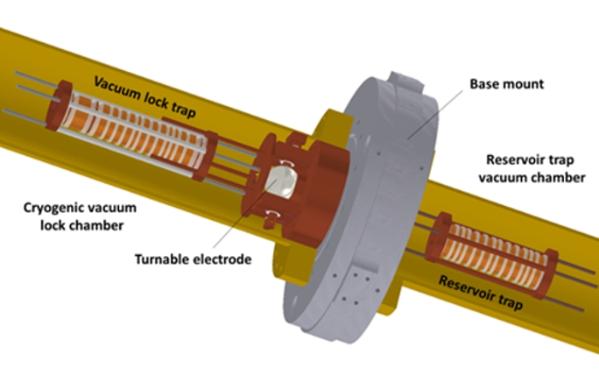BASE is developing a transportable antiproton trap for higher-precision antimatter measurements

AVA Supervisor Stefan Ulmer at the Max Planck Institute for Nuclear Physics is founder and spokesperson of the BASE collaboration at the European particle physics laboratory CERN. The collaboration aims at precise comparisons of the fundamental properties of antiprotons and protons. Such comparisons provide stringent tests of charge-parity-time reversal invariance which is the most fundamental symmetry in the Standard Model of particle physics. This Model predicts a certain difference between matter and antimatter, but this difference is insufficient to explain the imbalance. The teams behind BASE and other experiments located at CERN’s Antimatter Decelerator (AD) hall are searching for other differences between the two forms of matter.
The BASE team is now developing a transportable antiproton trap, to carry antimatter produced at CERN’s AD to another facility at CERN or elsewhere, for higher-precision measurements of the properties of antimatter. The challenge for these precision measurements is limited by external disturbances to the set-up’s magnetic field. Currently antiprotons produced at the AD are stored in a device called a Penning trap, which holds the particles in place with a combination of electric and magnetic fields. As the AD hall is not the calmest of the magnetic environments, this is not ideal for higher-precision measurements.

The cryogenic inlay of the BASE-STEP transportable trap in the magnet bore. Two separate vacuum chambers contain the two electrode stacks, one forming the vacuum lock trap, the other one the reservoir trap, where antiprotons are long-term stored and protected from residual gas by a turnable electrode, which blocks the direct path from the injection port to the reservoir trap. (image credit Christian Smorra/CERN)
Therefore, in order to be able to perform measurements at a laboratory with a calmer magnetic environment, the collaboration proposed to make a transportable antiproton trap to take antiprotons produced at the AD elsewhere. This device, called BASE-STEP, will consists of a Penning-trap system inside the bore of a superconducting magnet that can withstand transport-related forces. In addition, it will have a liquid-helium cooling system, which allows it to be transported for several hours without the need of electrical power to keep it cool. The Penning-trap system will feature a first trap to receive and release the antiprotons produced at the AD, and a second trap to store the antiprotons.
The overall device will be 1.9 meters long, 0.8 metres wide, 1.6 metres high and at most 1000kg in weight so that in principle the trap can be transported with a small truck or van. The research is led by BASE deputy spokesperson Christian Smorra, who received a European Research Council Starting Grant to conduct the project. BASE-STEP is expected to be completed in 2021, pending decisions and approvals. Further information can be found here.
AVA Fellow Markus Wiesinger is a member of the BASE collaboration and his project with the AVA Network is called Sympathetic Cooling of Antiprotons. His work focuses on advanced cooling techniques for protons and antiprotons in penning traps with the aim of improved measurements of the proton and antiproton magnetic moment.